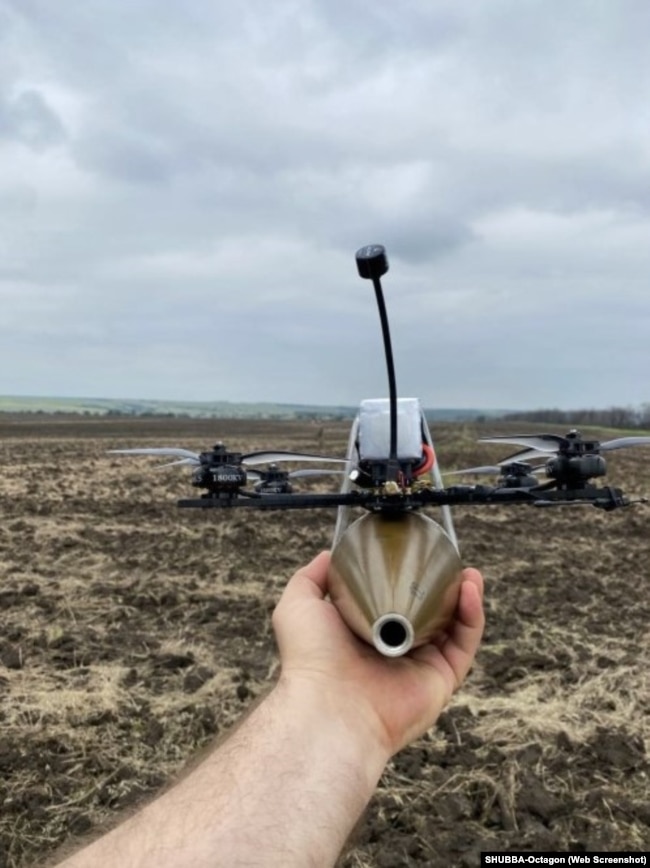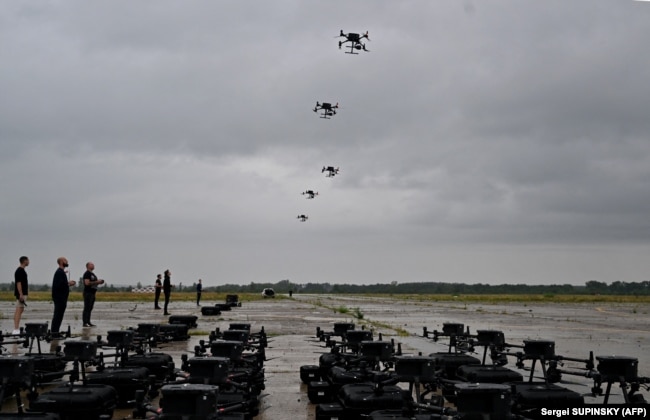Drone Wars
"At night we do bombing missions, and during the day we think about how to get new drones.""We're examining every possible way to export drones from China."Oles Maliarevych, 92nd Mechanized Brigade officer, Ukraine
 |
| A photo on SHUBBA-Octagon's website shows a DJI drone armed with an explosive. |
In
a basement eight kilometers from the front lines of the conflict Russia
imposed upon Ukraine, soldiers from the 92nd Mechanized Brigade work on
a deadly supply chain of cluster munitions, thermobaric bombs and
drones. Where hobbyist drones are converted to combat weapons. One
soldier attaches a modified battery to a quadcopter to enable it further
flight. On the battlefield, pilots zip-tie a homemade shell to the
bottom of the device to crash it into Russian trenches and tanks as
human-guided missiles.
These
airborne vehicles are so effective that those who modify them find it
difficult to keep up with demand. Yet sourcing new supplies is of and in
itself a full-time occupation. The conflict in Ukraine has become a war
of drones. Leaving those who use them heavily reliant on supply
sources. Large, military-grade drones are produced by Iran and Turkey,
while the inexpensive consumer drones largely are supplied from China.
Suppliers from China have yet to keep up their supplies that Ukrainians
reconstitute to weapons-grade.
Chinese
manufacturers such as DJI, EHang and Autel churned out drones at an
ever-increasing rate over the last decade. Now, however, Chinese
suppliers have become less reliable, less willing to expand and continue
their sales production. New rules restricting export of drone
components took effect a month ago. The traditional Chinese drone
producers who produce millions annually outpacing other countries with
DJI holding over 90 percent of the global consumer drone market, have
suddenly become sales-shy.
In
the past few months sales of drones and components to Ukrainians by
Chinese companies have been cut back. Those Chinese firms agreeable to
selling their products often require buyers to resort to the use of
intermediary networks for their purchase orders. Ukraine is in dire need
of drones and constituent parts and is prepared to beg, borrow and
smuggle what they need. Through use in the conflict, an estimated 10,000
drones monthly require replacement.
There
are fears rising that China's new restrictive rules on sale of drone
components could deleteriously impact the supply chain that Ukraine is
so dependent on. Which advantages Russia. Direct drone shipments by
Chinese companies to Ukraine totaled just over $200,000 in 2023 to June.
Russia, on the other hand, received $14.5 million in direct shipments
during that same time frame.
However,
Ukraine managed to obtain millions in Chinese-produced drones and
components, most arriving through European intermediaries, according to
customs data. Drones for reconnaissance, to drop bombs, and to use as
guided missiles remain the Ukraine military's focus. $1 billion has
been earmarked for a program to support drone start-ups and drone
acquisition efforts.
 |
| Ukrainian operators fly DJI drones at a training area in August. |
Mavic,
an easy-to-use quadcopter produced by DJI during the first weeks of the
war were what Ukrainian soldiers relied on. Then the company announced
plans to discontinue its business in Russia and Ukraine. Volunteers took
to bringing in the copters by the thousands to Ukraine, mostly from
Europe, while Russia discovered new channels through friendly neighbors,
at the same time continuing to order and receive Chinese export drones.
Hobbyist
racing drones strapped with bombs to act as human-guided missiles are
also on the front line scene this year. F.P.V.s, for first-person view,
in reference to the manner in which the drones are remotely piloted with
virtual-reality-like goggles are sold by a few mostly Chinese
companies, along with their components. Volunteers and companies work to
acquire as many F.P.V.s as possible, with Ukrainian suppliers reckoning
that soldiers likely require up to 30,000 of the devices monthly.
In
competition with Russia to acquire F.P.V.s from Chinese firms, Ukraine
deals with Russia having the advantage since it can bid higher and order
larger batches. From the perspective of Chinese producers,
additionally, selling to Russia has the advantage of being politically
safer, in view of the solidarity expressed between Moscow and Beijing.
"Today, we virtually do not use any Chinese components",
revealed Ukrspecsystems, a Kyiv company that manufacturers fixed-wing
reconnaissance drones, a result of supply chain issues leading it to
search for the requisite supplies beyond China.
 |
| A Ukrainian soldier in Kherson prepares to operate a commercial DJI Mavic drone |
Labels: Chinese Manufacture, Drone War, F.P.V.s, Hobbyist Drones Weaponized, Russian Invasion of Ukraine, Ukraine Military

<< Home